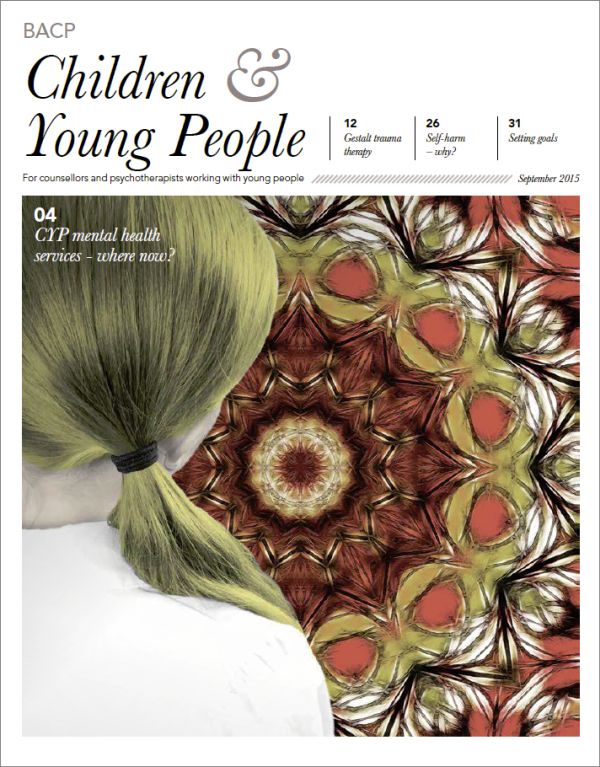In this issue
Features
CYP mental health services
Where now? Elaine Bousfield discusses her vision and the role of digital
Why do young people self-harm?
If we understand, we are better able to offer practical, sustainable support, says Pooky Knightsmith
Coach-therapy with young people
Why offer an all-in-one intervention? Eleanor Patrick explains
In practice
Gestalt therapy with traumatised children
Claire Harrison-Breed honours the child’s creative adjustments
The Human Social Functioning scale
Assessing family wellbeing holistically helps parents and children get their needs met. Susan Simpson reports
Setting goals in therapy
Aaron Sefi describes the use of CoGS, an interactive tool
Issues
Mindfulness in schools
Jackie Watson introduces and assesses .be (dot-be) – a Mindfulness in Schools Project
When both grief and trauma present
Alison Salloum specialises in providing combined interventions
Trauma: the body, the play and the drama (free article)
Sue Jennings writes about the building blocks of trauma recovery
Regulars
Reflecting on… labelling children
Jeanine Connor
Thinking about… attachment
Anna Jacobs
Considering… ghostwriting an autobiography
Nick Luxmoore

A pdf of this issue is available in the BACP Children and Young People journal archive
Welcome from the editor
When I read the seemingly constant stream of news items about cuts to young people’s services, counsellors being made redundant and agencies raising their thresholds (making access much harder, near impossible), I start to cut off. It’s as if a kind of numbness sets in and my ‘alert clock’ simply fails to register. Or maybe I’m starting to be in denial that these things are happening. Perhaps,some days, too, I even ‘miss’ the item despite having read ‘all the news’.
Isn’t this just a little bit like reactions to trauma? Yet there has to be a way through. Mental health provision for young people is currently in a frozen-in-time state, just like the traumatised young person, but if the younger generation is to thrive, there needs to be a way out of the impasse.
In this issue, Elaine Bousfield allows herself to imagine what a truly good young people’s range of services would look like – from proper financing, astutely aware commissioning and national roll-out, to locally sensitive, joined-up, wide-ranging provision from birth to 25. Is it so impossible for people who can track a probe to Pluto to achieve something workable? Currently, it seems as if the left brain and right brain of the powers that be are simply not making a connection – words not matched with genuine feelings and therefore not resulting in courageous actions. In all this, we must not forget the role of digital for ‘digital natives’, which, Elainea dvises, must be leveraged to its optimum, but in the right way alongside all other provision.
This envisioning of a ‘healed future’ for CYP services resonates strongly with my habit of helping clients imagine what ‘all better’ will look like. You cannot intentionally undertake the passage to somewhere you can’t construe. And I think, when dealing with trauma of all kinds – little-t and big-T –there is a need to join up the feelings to words and thence actions, in order to move towards resolution. Words help construe. But words can only be birthed within an attuned relationship. This cannot be hurried and depends very much on what Colwyn Trevarthen refers to in the Foreword of Through Windows of Opportunity as ‘micro-regulation processes in interpersonal interactions’1 – noticing and encouraging micro-moments of relationship and attunement. Not something easily taught or evidenced, but undoubtedly also underlying the interventions described or proposed in our three trauma articles here.
However we practise and whatever our specialism, if we attend to micromoments of attunement as well as models, macro tools and strategies, we may well discover a point in a young person’s life where a trauma or a series of traumas caused a rupture in the time-space continuum. Something unspeakable, forgotten or plain ignored. My experience is that when we attend to that moment, and the trauma is heard and processed appropriately within the attuned relationship, many of the subsequently acquired surface issues that are brought to therapy become unstuck. And the newly released energy in the child or young person is our reward.
Perhaps micro-attunement with young people is what is missing in government. Maybe we need some retired therapists to take up politics? That would surely release the frozen state of CYP mental health services and release the energy for the joined-up thinking and provision that Elaine envisions and most of us long for. It would certainly relieve my numbness about the current unacceptable situation.
Eleanor Patrick
Editor
Reference
1 Bentzen M, Hart S. Through windows of opportunity: a neuroaffective approach to child psychotherapy. London: Karnac; 2015.
